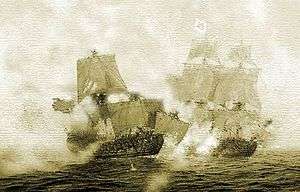Action of 28 November 1751
| Action of 28 November 1751 | |||||||
|---|---|---|---|---|---|---|---|
| Part of Spanish-Barbary conflict | |||||||
 Anonymous engraving depicting the final battle between the Dragón and the Danzik. | |||||||
| |||||||
| Belligerents | |||||||
|
|
| ||||||
| Commanders and leaders | |||||||
|
Pedro Fitz-James Stuart Luis de Córdova y Córdova | Mohammed Chirif (POW) | ||||||
| Strength | |||||||
| 2 ships of the line | 2 ships of the line | ||||||
| Casualties and losses | |||||||
|
3 killed, 25 wounded[1][2] |
1 ship of line sunk, 194 killed, 90 wounded, 320 captured, 50 slaves freed[1][2][3] | ||||||
The Action of 28 November 1751 was a naval engagement of the Spanish-Algerian conflict, fought off Cape St Vincent between a squadron of two Spanish ships of the line under Captain Pedro Fitz-James Stuart and an Algerian squadron of equal strength. Captain Pedro Fitz-James Stuart's ships pursued one of the Algerian privateers and managed to force it to surrender it after a fierce exchange of fire. The ship, badly damaged, had to be scuttled, but its surviving crew and 50 Christian slaves were rescued and taken aboard Stuart's flagship.
Background
In middle of the general peace obtained by the signature of the Treaty of Aix-la-Chapelle, Marquis of Ensenada ordered to assemble two naval divisions with the aim of fight the Barbary corsairs and to prevent the seamen of the Spanish fleet remain inactive.[4] Both divisions were dispatched to patrol the Barbary coast, where galliots and other minor vessels were frequently captured, but no significant engagement took place before November of 1751.[4]
Battle
On 28 November, while cruising off Cape St. Vincent in command of the 60-gun ships of the line Dragón and América, Captain Pedro Fitz-James Stuart sighted two corsairs owned by the Regency of Algiers 52 leagues of the Cape.[4] They were the 60-gun Danzik, flagship of the Algerian fleet, and the 54-gun Castillo Nuevo, being the first one under Arraez Mohammed Chirif.[5] Stuart approached to inspect them at 5 p.m. Then the Danzik raised the Algerian colors and opened fire against his flagship, the Dragón, but always trying to avoid the action by sailing toward the southwest.[5] The Castillo Nuevo took the opportunity to flee.[5]
The Danzik was pursued for an entire day, succeeding Chirif in avoid combat taking advantage of the windward, which prevented the Spanish ships open the ports of their gundecks.[5] However, she suffered damage to her rigging and sails, just as the Dragón.[1] For a moment, she strike her colors, but Chirif, obliged by his crew, ordered it to be hoisted again and resumed the action until the sunset, when both himself and Stuart declined to continue fighting due to rough sea.[1]
The next day the Spanish attacked again, inflicting heavy losses to the Danzik and causing irreparable damage to the ship. The loss on the Spanish side was negligible and amounted to be only 3 men killed and 25 wounded, compared to 194 killed and about 90 wounded on the Algerian ship, which, severely damaged, had to be set on fire after being transferred aboard Stuart's flagship 320 prisoners among who were Chirif, wounded during the battle, and 50 rescued Christian slaves, mostly Dutch.
Aftermath
Despite this defeat and some others such as the sinking of 3 xebecs off Benidorm or the capture of the Castillo Nuevo seven years later, the Barbary corsairs continued threatening the commercial traffic in the Mediterranean until 1786, when, after two successful Spanish expeditions under Antonio Barceló which bombarded Algiers inflicting heavy damage, the Dey of Algiers agreed to interrupt the actions of their privateers, being imitated shortly after by the Dey of Tunis.[6]
Notes
References
- Español Bouché, Luis (1999). Nuevos y viejos problemas en la Sucesión de la Corona Española: Pragmática de Carlos III sobre matrimonios desiguales. Derechos a la Corona de los hijos naturales. Necesidad de una Ley de Sucesión. Doña Teresa de Vallabriga. Madrid, Spain: Ediciones Hidalguía. ISBN 978-84-89851-13-9.
- Fernández Duro, Cesáreo (1895). Armada Española desde la unión de los reinos de Castilla y Aragón. II. Madrid, Spain: Est. tipográfico "Sucesores de Rivadeneyra".
- Marqués De Laurencín. Don Agustin de Montiano Y Luyando. Real Academia de la Historia.
- Carlos Martínez-Valverde y Martínez/Antonio Luis Martinez Guanter: Biografía de don Pedro Fitz-James Stuart y Colón de Portugal Revista de Historia Naval (Spanish)
- Sabater Galindo, Javier: El Tratado de Paz Hispano-Argelino de 1786 Departamento de Historia Moderna. Universidad Complutense. Madrid (Spanish)